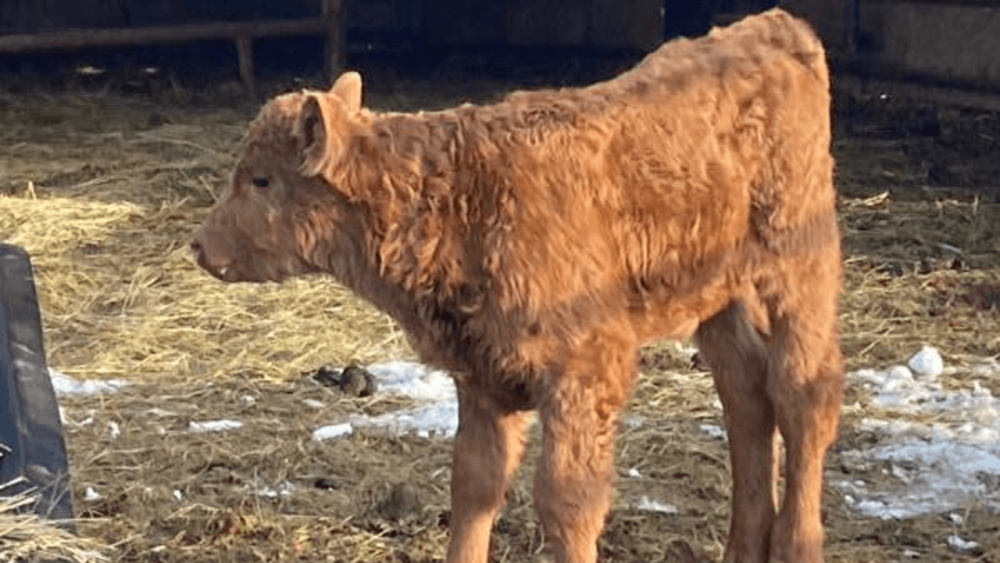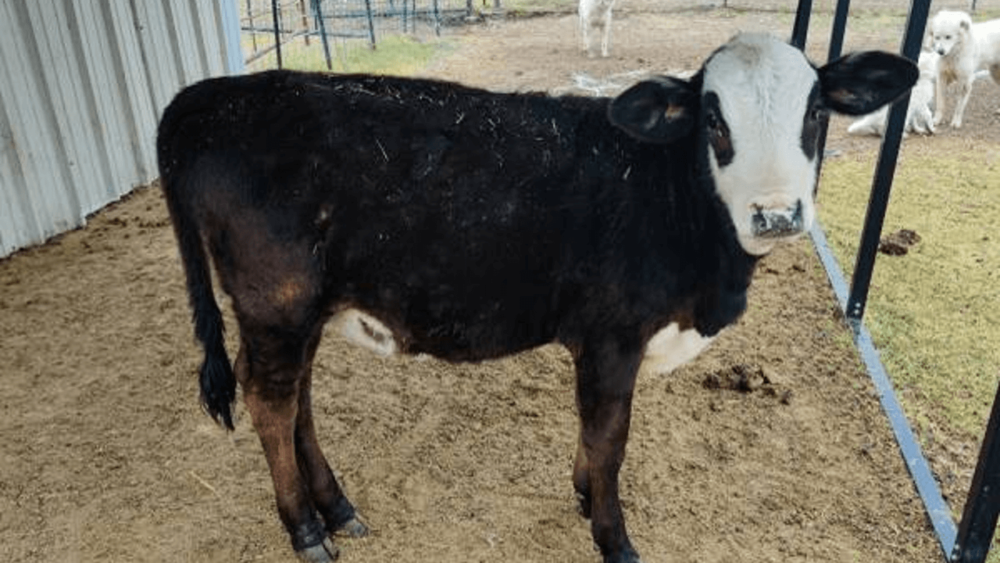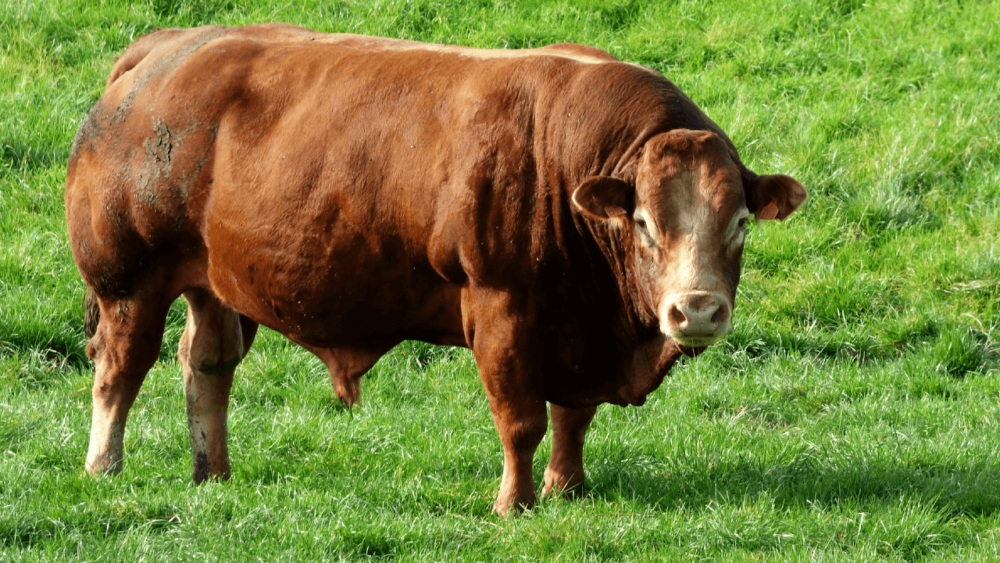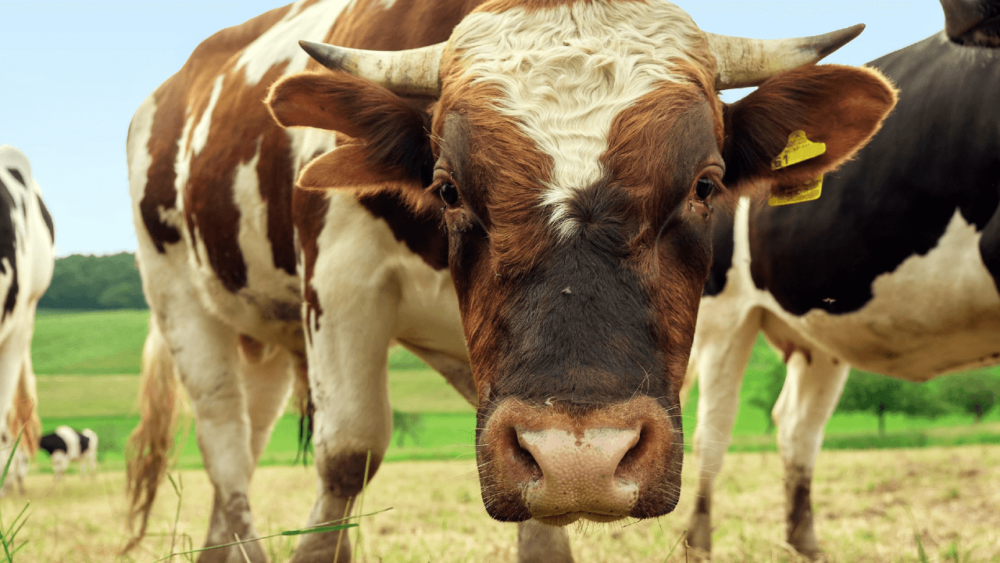If you are looking to buy a cow to raise or butcher, for milk or meat, you’ll notice that the prices for cattle vary quite a bit. Unless you are used to buying cows, it can be pretty confusing. This article breaks down the factors that affect the cost and value of a cow. Here’s a summary:
- Bottle-fed calves cost as little as $100-200 and as much as $400. They are at a higher risk because so many bottle calves die of various complications
- Weaned calves usually cost $400 and higher, depending on their weight. Weaned calves are generally larger and healthier.
- Yearlings are calves that are 1 year old. They usually start around $600 and up. A lot of their value lies in their weight and gender.
- Heifers are female cattle that haven’t had a calf yet. Their value usually starts at about $900 and up.
- Cows have birthed (calved) a calf. Their value usually starts at $1,200 and higher.
- Bulls for breeding usually cost about $1,000
- Steers, used for beef, usually cost about $145 CWT or about $1.45 per pound.
Buying a Bottle Fed Calf Usually Costs Less Upfront, but More Later
Calves are hard to raise. The younger they come, the easier they die. And calves can die very quickly and without warning. When purchasing a calf, you must consider your experience level and tolerance with death.
Bottle calves are usually young enough that they can’t eat hay. Calves usually bottle feed for 5-10 weeks. So, most bottle-fed calves are under 2 months. And, you’ll want to bottle feed longer than usual to help the calf grow at the same rate as the mamma-nursed calves.
Because they are so tiny, they have a higher mortality rate. As a result, bottle-babies are usually half or a third the cost of a weaned calf.
How Much Does A Bottle Calf Cost?
A bottle calf usually costs $200-$300, but you might be able to get one for under $200 if you shop around. You should also plan to spend at least $175-$200 on milk supplements until you wean weaned it, and a little grain as it weans. Weaned calves cost twice what a bottle-baby usually costs.
Bottle babies can die suddenly. If you purchase bottle calves, you should prepare for some, or all, of them, dying. It’s not a guarantee, but it is something you should be prepared for, especially if you have no experience caring for cows.
Even experienced cattle raisers have calves die. They can die of pneumonia, scours, other diseases, or genetic issues. Sometimes calves plain die- for no apparent reason. And it’s heartbreaking.
Bottle babies are adorable. If you want to raise a bottle baby, it’s a good idea to get some experience with a grown cow, breed her, and learn the basics of caring for a cow without the added stress and risks that a bottle calf comes with.
If you have cow experience, a bottle calf is fun and can be less costly. Many first-timers luck out with bottle-fed calves. But, a bottle baby can cost hundreds or thousands more in vet bills, feed supplements, and additional risks that only experience can help reduce. Even when bottle calves live, they are often more costly than weaned calves or yearlings because of the milk supplement costs.

Weaned Calves
Depending on the practices of where you buy your calf from, it could be as young as 8 weeks or several months older when it weans. Everybody does it differently. Some raisers prefer to wean early and use the milk, while others let the cows grow for many more months and wean naturally. Natural weaning can happen as late as 6 or 7 months.
Find out how old your weaned calf is. Double-check if it was a bottle-fed calf or if it nursed from its mom. If it was bottle-fed- make sure it got colostrum. The colostrum helps to set a calf’s immune system and plays a part of its health for life.
Weaned calves have a higher chance of success. They are still at risk of death or disease, but they are generally healthier (and it’s easier to tell if they aren’t).
How Much Does A Weaned Calf Cost?
Weaned calves usually cost between $500-$1,000 apiece. Weaned mini cow calves typically cost between $1,000-$1,500 each in the upper end. Highland, Limousin, Brangus, and Aberdeen often cost $800-$1,000, while weaned Angus, Holstein, Zebu, and other breeds can be lower or priced by weight.
While researching the average calf prices around the United States, I found many sales for weaned calves only 4-5 weeks old. These calves are more likely to grow slower and struggle because their stomachs aren’t ready for hay.
As a general rule, the younger a calf is weaned, the lower it’s prices are, compared to a bottle-fed calf. Most weaned calves will usually be at least 2-3 months old. I used calves between 3 months and 10 months to get the averages listed above. 11-month-old calves were rounded into yearling calf prices.

Yearling Calves Are More Dependable Calves
A yearling calf is a calf that has reached a year old. They are usually healthier than younger calves, and although not quite fully grown, they are growing much larger. Yearlings typically weigh about 600-750 pounds.
Yearlings are nice because any physical issues or negative manifestations are a lot easier to identify than when calves are younger. This makes it more likely for a less-experienced buyer to buy a bad calf. It’s still a good idea to bring an expert with you, though!
When you purchase a yearling, you’ll pay a few hundred dollars less than a fully-grown cow or bull. That’s because they still have a little growing and finishing left to do. Finishing is that final thrust of weight a yearling needs to put on before it’s at full-size.
How Much Do Yearling Calves Cost?
As a general rule, the most expensive yearlings are heifers, which usually price between $800-$2,000, depending on the breed and lineage of the heifer. Bulls with the same breed and parentage usually price $200-$300 below their heifer counterparts. Steer yearlings price another $200 or so below bulls.
If the bull or heifer is not of high enough quality for breeding, it will get pulled into a beef calf. Because breeding requires fewer bulls than heifers, most bulls are made into steers. (Heifers aren’t steers but are fattened for butchering).
A good-quality bull with a bad temperament or a slight physical issue can be made into a steer, especially when there are other quality opinions for a good bull. Steers are castrated males who are raised for meat.
- All other factors equal, heifers usually sell for more than bulls. Steers sell for the least of yearlings.
- Steer: A castrated male calf raised for meat.
Heifers Versus Cows: Understanding Price Variations
Heifers are cows that have not given birth yet. Cows are female bovines (or cows) that have given birth. Whether you are purchasing for a beef herd or a dairy herd, you want females that will birth easy and have healthy babies.
There are so many factors that make raising cows easier. Good mamas will produce enough milk, accept their calves, and maintain health.
Heifers Have Unknown Reproductive Abilities
When you purchase a heifer, all of her mothering abilities are unknown. She may be easier to breed and have uncomplicated pregnancies and births. Or, she may have difficulty breeding or have troublesome births, reject her calves, or have other issues.
Cows have given birth. Often new buyers prefer to purchase a cow with a proven history in birthing and milk production. Freshening is the term used to express that a cow has birthed and provided milk. First freshening happens after the first birth.
- Heifers are female cattle that haven’t given birth before and may have unknown issues with:
- Getting pregnant from breeding with a bull
- Pregnancy issues
- Her health issues during pregnancies
- Birthing issues
- Be a poor mamma (reject the calf, etc.)
- Have inadequate milk supply
- Other problems related to reproductive health

It’s also essential to realize that heifers should give birth within the first 2 years of their lives. A heifer that is more than 2 years old without a confirmed pregnancy may have issues conceiving or maybe a freemartin.
Cows Are Usually Worth More Because They Have Successfully Given Birth
Cows are female cattle that have given birth. They have a lower likelihood of reproductive and birthing issues than heifers. If a cow has issues birthing, she is usually culled or is sold at a steep discount.
- A cow’s reproductive issues are often known.
If the breed, quality, and lineage are equal, a cow will sell for between $200-$500 more than a heifer because she has proven her abilities in providing valuable offspring. The value of a cow will increase if she produces exceptionally high-quality offspring.
Breeders often seek smaller calves that gain weight quickly for beef cattle and high quality or quantity of milk for dairy cattle.
A cow that has already freshened and had no issues with milk supply or mastitis will be worth much more than a cow that struggled with these issues. Cows can sell for between $1,500-$2,200, while heifers of the same quality will usually sell for $900-$1,500. If a cow sells for less than the usual price, she is likely old or has had reproductive issues. Make sure you ask the right questions.
In my research, I found that most cows are sold either as a pair with a young calf or already bred for the next season. Many knowledgeable owners listed the number of calves the cows have birthed.
- Cows with quality reproduction and milk supply are worth more than heifers
- Cows with poor milk supply or birthing issues are usually worth less than heifers
- Heifers are typically worth less than they are after a birthing season
Proven Bulls Versus Yearling Value
When bulls are listed for sale, they are confirmed, tested, or unconfirmed. The primary purpose of a bull is to breed. A quality bull should breed effectively, know what to do, and produce good offspring.
Bull calves are usually unconfirmed. Some bull calves will have vet tests to confirm their potential to breed. The vet will sample their semen and do a number count.
Proven bulls will be at least a couple of years old and have successfully bred cows.
Bottle bulls tend to cost over $100 and up to $300. As the bulls gain weight and develop well physically, their value increases. A seven-month bull costs between $450 and $750, depending on the breed. Proven bulls range between $1,000 and $2,500 on average.
As bulls prove their value, they can cost even more. Registered, high-performance bulls can cost as much as $6,000 or more.
- Once a bull proves his abilities, his value increases by $800-$1,500
Steer Calves Are Usually Worth Less Than Bulls and Heifers
Steers are usually at the bottom of the value totem pole for cattle. Along with steers, cows with issues birthing are generally slated for culling. Culled cattle are usually animals that have failed to meet breeding requirements somehow.
Steers and culled cows are butchered and used for beef. Cows can be culled if they get mastitis which can be difficult to cure permanently. Cows are usually culled when they struggle with calves, pregnancy, or calving issues.
Bulls that aren’t as high-quality for breeding get castrated into steers. Often, even good-quality bulls will be steers because there just isn’t as much of a need for bulls.
- Steer calves usually cost $200 less than their bull cousins

The Costs Differences Between Breeds
Some breeds increase the value of a cow or a bull above the usual range of costs for a cow. Limousine, Gallaway, Simmental, Gelbveih, and Brown Swiss cattle usually cost more than common breeds. The average prices for these breeds ranged as high as $2,000-$3,500. Registered cows or bulls from these breeds sometimes pushed prices even higher.
Mini cows, of all breeds, also tend to cost more than a regular cow. This may be because they are rare, and there isn’t as high of a supply of mini cows. Mini cows are also a current trend that pushes their popularity higher. They are simply adorable.
Lowline, longhorn, Angus, and Aberdeen are more common breeds that tend to push the prices for an adult cow into the $2,000 and higher price range.
Prized and Registered Cattle Cost More
Around the country, registered or prized cows and bulls cost more, as did their offspring. For example, in Arizona, a proven Angus bull often commanded $1,000-$1,500. But, a high-quality registered Angus bull might cost as much as $6,500.
In Illinois, an Angus bull could easily cost $1,600, but a registered bull in the same area quickly goes for $3,000. A registered bull costs about $1,000 more than an unregistered one in Wisconsin.
Purebred cows can also command more than crosses. And, mixed breeds of two rare breeds can command higher prices.
- Registered or purebred cows can cost as much as $1,000+ more than unregistered counterparts.
Your Location Will Affect A Cow’s Price
Around the country, cow prices vary. According to the USDA, Arizona and Wisconsin had higher average prices for cattle than anywhere else in the country. Utah and Virginia had the lowest. But, I found that there is a lot of variance within each state. Supply and demand create price variations every few weeks.
I also found that there can be many variations within each state. Often rural areas have more supply than urban areas, but there are greater distances between farms. As you shop for the right cow, take time to watch your area so you can best assess what cows are available.
Older Cows Might Provide a Great Option
Cows can live as long as 20 years old. But, their reproductive life is at its best for 10 years. After 10 years, an older cow usually struggles with fertility, birthing issues, or milk supply.
Once a cow reaches about 7 or 8 years, her value starts to drop more drastically. The average lifespan of an agricultural cow is 10 years.
As cows pass 8 years of age, their cost and value will decrease each year. How much depends on whether or now she is still strongly producing and how much her milk production has decreased. A cow with increasing health struggles will also decrease in price.
Where Can I Buy a Cow?
There are many places to purchase cattle. Online, there are several auctions where cows are sold. In addition, most areas have local cattle auctions. Craigslist is popular for homesteaders to feature cows for sale.
Because Facebook has a ban on live animal sales, local animal groups may provide access to local breeders. Although communication has to start on Facebook, it should move off the platform.
A local dairy can also be a great option if you want to purchase a dairy cow. When a dairy cow decreases in production, they usually get sold. But, the same cow is often still producing more than enough milk for family use.
- Ranch World
- United Producers
- The Cattle Range
- Drovers Cattle Exchange
- Cows for sale near me
- Craigslist.com
After reading this, check out our other articles on:
- How Much Does a Cow Cost to Buy? 2024 Cattle Prices
- Critical Questions to Ask When Buying a Family Dairy Cow
- Mini Cow Prices in the US: What They Really Cost
Conclusion
In the quest to buy a cow, whether for raising, butchering, or dairy purposes, navigating the varied prices can be a challenge for newcomers. This article has elucidated the factors influencing the cost and value of cows, breaking it down into understandable segments. From the more affordable bottle-fed calves at $100-200, susceptible to higher mortality rates, to the more robust weaned calves starting at $400, the journey through calf to cow ownership is fraught with considerations.
Yearlings mark a significant step up, with prices beginning at $600, reflecting their closer approach to maturity and lesser risk compared to younger calves.
Heifers, not yet mothers, command prices starting at $900, with their value tied to potential reproductive success. Cows, having proven their birthing abilities, start at $1,200, offering a more reliable investment. Bulls, essential for breeding, hover around $1,000, while steers, designated for beef, are priced by weight at approximately $1.45 per pound.
Recommended Cattle Supplies (And Dairy Supplies)
This list contains affiliate products. Affiliate products do not cost more but helps to support BestFarmAnimals and our goal to provide farm animal owners with accurate and helpful information.
This shelter is pretty easy to put together and it shelters a good number of cows. It’s sturdy and can withstand our high winds and heavy snows. And it’s cheaper than a barn and easier to build.
Colostrum is critical for calves. If you aren’t able to get some from your cows, this is a quality supplemental colostrum.
Probiotic for cattle with digestion issues in a oral tube. It works for other ruminants and is safe for goats, but is formulated especially for cattle.
A halter to lead Bessie around. This show halter also works for kids showing for 4H.
All Stock Feed is on Amazon, but you’ll pay less if you find it at your local feed store. It’s a great feed for cattle.
Electrical rope for your fencing. This keeps cattle in, but goats, alas- not so well.
Dairy Cow Recommended Supplies
Disposable towels or wet wipes are the first step in cleaning the udders.
Teat Dip and a dip cup are essential for keeping your milk clean. It lasts a while. Mine usually lasts a year to a year and a half.
I use a stainless steel bucket when I milk because it’s easy to clean and carry. These are my preferred milk filters and I use them for cow and goat milk.
This large jar funnel stays much more stable than regular funnels and can handle larger milk volumes.
I like this grain feeder while milking and use this size for the cows and goats being milked.
Balm ointment for sore udders. This cream is popular for people but formulated and created for cows’ udders.
Mastitis Test detects mastitis.

